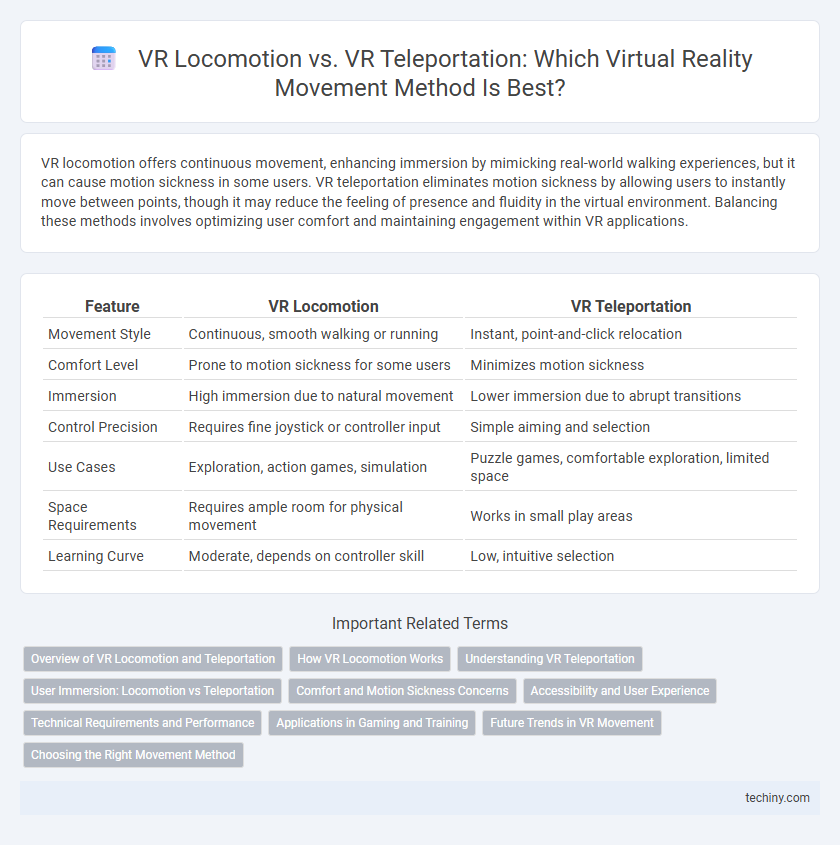VR locomotion offers continuous movement, enhancing immersion by mimicking real-world walking experiences, but it can cause motion sickness in some users. VR teleportation eliminates motion sickness by allowing users to instantly move between points, though it may reduce the feeling of presence and fluidity in the virtual environment. Balancing these methods involves optimizing user comfort and maintaining engagement within VR applications.
Table of Comparison
| Feature | VR Locomotion | VR Teleportation |
|---|---|---|
| Movement Style | Continuous, smooth walking or running | Instant, point-and-click relocation |
| Comfort Level | Prone to motion sickness for some users | Minimizes motion sickness |
| Immersion | High immersion due to natural movement | Lower immersion due to abrupt transitions |
| Control Precision | Requires fine joystick or controller input | Simple aiming and selection |
| Use Cases | Exploration, action games, simulation | Puzzle games, comfortable exploration, limited space |
| Space Requirements | Requires ample room for physical movement | Works in small play areas |
| Learning Curve | Moderate, depends on controller skill | Low, intuitive selection |
Overview of VR Locomotion and Teleportation
VR locomotion simulates natural movement using techniques such as joystick navigation, walking-in-place, or treadmill setups to enhance immersion. VR teleportation enables instant repositioning within the virtual environment by pointing and selecting destinations, reducing motion sickness. Both methods address different user comfort levels and gameplay styles, impacting overall user experience in virtual reality.
How VR Locomotion Works
VR locomotion works by translating a user's physical movements into virtual space navigation through input devices like joysticks, treadmills, or motion sensors. This method enables continuous, smooth movement within the VR environment, enhancing immersion and spatial awareness. Advanced locomotion systems often combine real-time tracking and predictive algorithms to reduce motion sickness and improve user comfort.
Understanding VR Teleportation
VR teleportation offers a motion technique allowing users to instantly move between points within a virtual environment, reducing motion sickness commonly associated with continuous VR locomotion. This method enhances user comfort and spatial orientation by providing discrete transitions rather than smooth movement, which can cause disorientation or nausea. Understanding VR teleportation involves optimizing transition animations and user controls to maintain immersion and navigational efficiency in virtual reality experiences.
User Immersion: Locomotion vs Teleportation
VR locomotion methods, such as joystick or natural walking, provide continuous movement, enhancing user immersion by creating a seamless and realistic spatial experience. Teleportation, while reducing motion sickness and simplifying navigation, can disrupt immersion due to abrupt scene changes and loss of spatial continuity. Studies show users often report higher presence and engagement with locomotion systems despite increased risk of discomfort, highlighting a trade-off between immersion and usability.
Comfort and Motion Sickness Concerns
VR locomotion offers an immersive movement experience but often causes motion sickness due to visual-vestibular mismatch, especially during continuous walking or running simulations. VR teleportation significantly reduces motion sickness by instantly repositioning the user, minimizing sensory conflict and enhancing comfort during prolonged sessions. Comfort levels in VR environments are highly dependent on the locomotion method, making teleportation the preferred choice for users prone to motion sickness.
Accessibility and User Experience
VR locomotion offers a continuous movement experience that can enhance immersion but may cause motion sickness in sensitive users, impacting accessibility. VR teleportation significantly reduces discomfort by allowing instant repositioning within the virtual environment, providing a user-friendly option for those prone to nausea. Balancing these methods improves overall user experience by accommodating both accessibility needs and immersion preferences.
Technical Requirements and Performance
VR locomotion demands high frame rates and low latency to maintain immersive, natural movement, requiring advanced motion tracking sensors and powerful GPUs to render smooth continuous environments. VR teleportation reduces motion sickness risks by instantly moving users, minimizing the need for real-time positional data and thus lowering computational load and sensor precision. Technical performance in teleportation favors optimized scene transitions and boundary detection algorithms, while locomotion prioritizes seamless input integration and predictive motion smoothing to prevent disorientation.
Applications in Gaming and Training
VR locomotion offers immersive, continuous movement ideal for realistic gaming environments and training simulations requiring spatial awareness, such as military or medical scenarios. VR teleportation reduces motion sickness and allows rapid repositioning, enhancing user comfort and efficiency in fast-paced or complex virtual tasks. Both methods are essential in designing adaptive VR experiences that balance realism and user accessibility for diverse training and entertainment applications.
Future Trends in VR Movement
VR locomotion methods are evolving with advancements in haptic feedback and motion tracking, enabling more natural and immersive user movement. Emerging technologies like neural interfaces and AI-driven predictive algorithms aim to reduce motion sickness and enhance spatial awareness. Future trends in VR movement prioritize seamless integration of physical and virtual motion to create highly intuitive and comfortable experiences.
Choosing the Right Movement Method
Selecting the optimal VR locomotion method depends on user comfort, environment scale, and interaction goals. VR teleportation minimizes motion sickness by providing instant repositioning, while continuous locomotion offers greater immersion through natural movement simulation. Prioritizing accessibility and gameplay mechanics ensures an effective balance between user experience and virtual exploration.
VR locomotion vs VR teleportation Infographic

 techiny.com
techiny.com